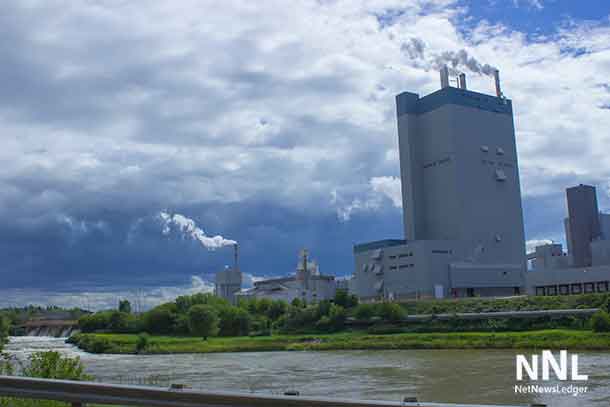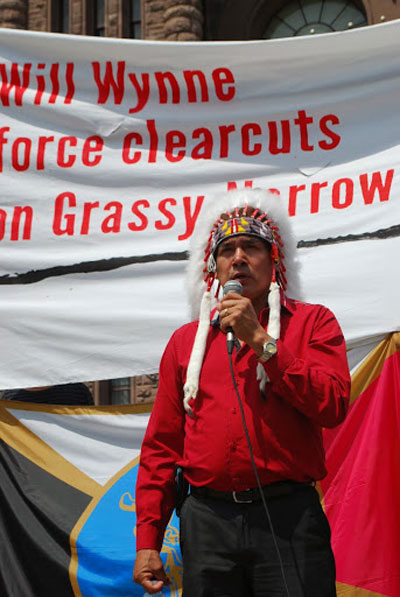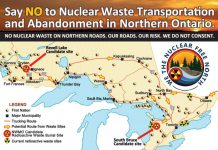
DRYDEN / TORONTO – “I am shocked to hear that mercury contaminated soil has been found behind the mill after Ontario assured us that the hidden mercury dump reported by Kas Glowacki did not exist,” says Grassy Narrows Chief Simon Fobister. “We need an immediate investigation into mercury at the whole Dryden mill site by our trusted experts to tell us whether we are in danger from mercury dumps and leaks. We live downstream from that area and we rely on the fish from the river.”
The Chief of Grassy Narrows First Nation in Northwestern Ontario is speaking out today after learning that evidence of a poisonous mercury dump has been found behind the Dryden paper mill, upstream from this Indigenous community where many people suffer from mercury poisoning.
The Chief is calling for immediate access to the mill site for Grassy Narrows’ experts to investigate, and he is calling for the Wynne and Trudeau governments to clean up any mercury contamination that is found. Mercury is a potent neuro-toxin that damages the brain and nervous system leading to loss of vision, touch, balance, and coordination as well as learning disabilities with lifelong impacts.
The Chief wrote on Friday to Minister Glen Murray, and Domtar CEO John D. Williams requesting that they grant access to the Dryden mill site for Grassy Narrows’ experts to conduct a thorough investigation into improper mercury disposal.

For generations people living near the English River Wabigoon River system have shown the impacts of mercury poisoning. The mercury in the water system came from the paper mill in Dryden Ontario.
Last week, Earthroots an environmental group reported they have found evidence of a poisonous mercury dump behind the Dryden paper mill, upstream from the Grassy Narrows First Nation where many people suffer from mercury poisoning. A soil sample from the site collected by Earthroots volunteers contains hundreds of times the level of mercury found in a nearby uncontaminated site.
The location is within the circle drawn on a map by Kas Glowacki, a former mill worker, to show where he buried 50 barrels of mercury and salt haphazardly in a pit behind the mill in 1972.
Mercury is a potent neuro-toxin that damages the brain and nervous system.
Earthroots, in a media statement says, “This key evidence comes to light shortly after the Wynne government told the legislature on November 23rd that “We have completed very extensive tests… and found there are no barrels buried and there is no source [of mercury]”.”
Grassroots volunteers for Earthroots, an environmental group, found the contaminated soil in a weekend excursion using a hand-held metal detector.
For generations, the impact of pollution from the mill in Dryden has impacted the region.
In 2015, a government commissioned report has found that mercury levels in the sediment of Grassy Narrows’ Wabigoon River remain up to 20 times above natural levels, while fish are up to 15 times above consumption guideline levels.
This places the river above the frequent adverse effects level – the highest risk threshold used by Environment Canada to trigger remediation in the St. Lawrence environmental risk assessment.
The Wabigoon River is the site of one of Canada’s most infamous ongoing environmental health disasters which began when 9,000 kg of mercury were dumped by a paper mill upstream in the 1960’s. No clean-up has been done even though multiple generations of Grassy Narrows families have been poisoned by the mercury.
In the letter Grassy Narrows Chief Simon Fobister writes “This site and surrounding areas need to be tested immediately so that we can locate any ongoing sources of mercury and assess the extent of the contamination. It is critical that our First Nation lead those studies so that we may trust in the results… We demand that the site and surrounding areas remain undisturbed until our experts have an opportunity to conduct the necessary tests. This is an urgent concern for us.”
Domtar Responds
Yesterday Domtar, the current owner of the Dryden mill property, responded to the Chief but did not grant access for Grassy Narrows’ experts to search for Glowacki’s toxic barrels on the property where mercury contaminated soil has now been found. Previously, in an August 9 letter, Domtar explicitly denied Grassy Narrows’ earlier request for access to the mill property to search for the barrels.
“Domtar does not consent to provide access to the Dryden mill property to grassy Narrows or its representatives for environmental testing or survey work,” wrote David Struhs, Domtar Vice President for Corporate Services and Sustainability on August 9, 2016.
NDP MP Charlie Angus comments, “Check out Domtar’s reaction to finding massive levels of mercury contamination at the same spot that workers said they were told to bury barrels of mercury at Grassy Narrows: ‘We were surprised to learn that the Toronto Star entered and disturbed private property without permission. We ask that you respect our rights and avoid a trespass situation in the future’.”
“90% of the people of Grassy Narrows have been poisoned by mercury. I think the federal and provincial government have respected Domtar’s corporate “Rights” for far too long. It’s time to respect the rights of the people who have been poisoned,” states Angus.
Volunteers from Earthroots, an environmental group, recently found highly contaminated soil in the area where Kas Glowacki, a former mill worker, says he buried 50 barrels of mercury and salt haphazardly in a pit behind the mill in 1972.
Three generations of Grassy Narrows families bear the terrible burden of mercury poisoning on their bodies and brains. Fishing is a central part of Grassy Narrows’ culture which has provided sustenance and livelihood for countless generations of Grassy Narrows people. The collapse of fishing as a result of mercury poisoning created massive unemployment and poverty in the community which persists to this day. Social services are underfunded and youth suicides are on the rise in this formerly self-sufficient and healthy Indigenous nation.
“The government has always told us that since 1970 the mercury at the mill was safely disposed of and our river was healing. It appears that this is not the case. We need a clear, written commitment from Premier Wynne and Prime Minster Trudeau to clean our river, including making sure that the Dryden mill site is not leaking mercury,” said Chief Simon Fobister. “Every day that the Wynne and Trudeau governments delay there is a risk that more Grassy Narrows babies will be born into a lifetime of hardship caused by mercury.”
An expert report released last May found that Grassy Narrows’ Wabigoon River is still highly contaminated more than four decades after controls on mercury releases were put in place, indicating that there is an ongoing, but unidentified, source of mercury. The scientists concluded that the river can and must be cleaned up safely.
Grassy Narrows first learned about the barrels in August of 2015 in a letter from Kas Glowacki, a former mill worker who reports that he was part of a crew that filled, dumped, and buried fifty toxic barrels behind the mill in 1972. Glowacki wrote “[t]he drums were dropped not placed into the pit… I can attest to the fact that there was several Hundred (sic) pounds [of liquid mercury] buried up on the hill above the river.”
Former Grassy Narrows Chief Roger Fobister Sr. forwarded Glowacki’s letter to the government. On November 12, 2015, MOECC officials responded to the chief saying that “The Dryden pulp mill is not a source of mercury.”
In June of this year, after a Toronto Star investigation exposed the government’s failure to act on Glowacki’s tip, a spokesperson for the MOECC told the Star that the ministry is doing “everything in its power” to find the site. The government searched for the barrels this summer using geophysical sensors but concluded there was no evidence of the barrels. But it appears that they searched in the wrong place.
On November 23rd the Wynne government told the legislature that “We have completed very extensive tests all across the site… and found there are no barrels buried and there is no source [of mercury].” That same day Minister Murray told the legislature “I will promise that we will… get the cleanup [of the English-Wabigoon River] to the satisfaction of the chief and the health of the people of Grassy Narrows.”
Grassy Narrows’ Chief Simon Fobister responded saying “I invite the Premier to put this historic commitment in writing and sign it alongside me in proper ceremony so that we can know it is real. We have borne 54 years of poison and inaction – we need a firm timeline and a realistic budget to get this cleanup done as soon as humanly possible. We will not rest until our fish are safe to eat again.”
However, the following day Premier Wynne back tracked and refused to commit to cleaning the English-Wabigoon River claiming that it would risk releasing old mercury.
The Toronto Star reported that, when asked, her government provided no evidence of risk associated with the clean-up methods recommended by the expert report. Dr. David Schindler, founder of the Experimental Lakes Area, wrote to Premier Wynne saying that “this fear is needless” and urged the Premier to proceed with the reclamation of the river.
A recent report by Japanese mercury experts found mercury poisoning symptoms in 90% of people tested in Grassy Narrows First Nation and Wabaseemoong Independent Nations in 2014, including younger people. Another expert report by Canadian mercury expert Dr. Mergler found that between 1978 and 1992 many babies were born in Grassy Narrows with umbilical cord blood mercury levels high enough to cause permanent brain development impacts.





